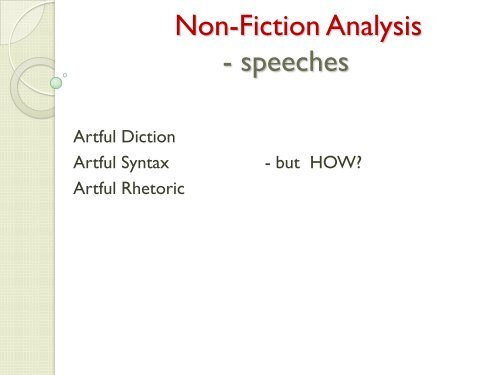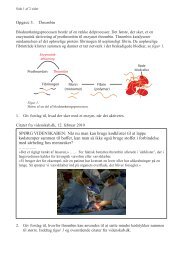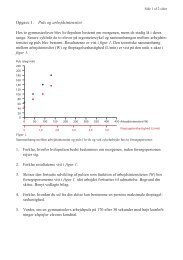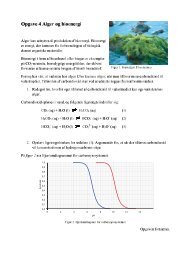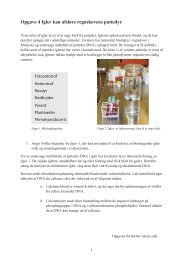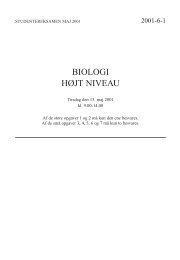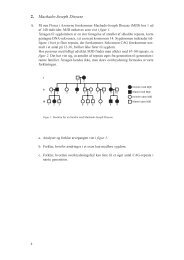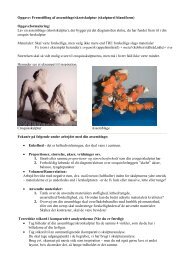Non-Fiction Analysis - speeches
Non-Fiction Analysis - speeches
Non-Fiction Analysis - speeches
Create successful ePaper yourself
Turn your PDF publications into a flip-book with our unique Google optimized e-Paper software.
Artful Diction<br />
<strong>Non</strong>-<strong>Fiction</strong> <strong>Analysis</strong><br />
- <strong>speeches</strong><br />
Artful Syntax - but HOW?<br />
Artful Rhetoric
Speeches -written to be spoken and heard<br />
• Speeches are writen to be spoken in real time.<br />
•Words are not to be read but to be heard => sounds are important too!<br />
• The audience cannot “rewind”=><br />
•Therefore key points of the speech must be very clearly expressed<br />
•Strategies to ensure the audience can remember the message are important!
What makes a speech memorable/powerful?<br />
Typical genre conventions for <strong>speeches</strong><br />
• Attention grabbing opening<br />
(To establish the speaker’s ethos + connect with the audience)<br />
• Clarity of structure – so the audience can follow the speaker’s points.<br />
• Clear and memorable message(s) since the audience cannot re-read it<br />
• Powerful and engaging, but audience-friendly vocabulary + imagery<br />
• Repetition of words, phrases, sentences (often the rule of three is popular to<br />
create redundancy<br />
• Appropriate tone and formality level (adapted to both subject and audience)<br />
• Memorable ending.
TOOLBOX for speech analysis<br />
Tool 1: Argumentation analysis<br />
(argumentationsanalyse)<br />
Tool 2: Message functions<br />
(tekstfunktioner)<br />
Tool 3: Rhetorical Appeals<br />
retorisk analyse<br />
Tool 4: Stylistic analysis (stilistisk analyse)<br />
Tool 5 Discourse markers (diskursmarkører)<br />
The tools will be introduced in the following slides
TOOL 1: <strong>Analysis</strong> of Argumentation:<br />
(argumentationsanalyse)<br />
Argumentative text types/genres:<br />
Essays<br />
Political party programmes<br />
Feature articles (kronikker)<br />
Letters to the editor (læserbreve)<br />
Political <strong>speeches</strong><br />
Etc.
TOOL 1. Argumentation analysis:<br />
(argumentationsanalyse)<br />
The argument:<br />
claim (påstanden): the X that the<br />
sender wants to convince someone about<br />
data (belæg for påstanden)<br />
the reasons/grounds used to support the claim<br />
Warrant (hjemmel)<br />
the further developed reasons/grounds<br />
given to support the data
TOOL 1. Argumentation analysis<br />
(argumentationsanalyse)<br />
EXAMPLE: “Children are overweight. They drink a lot of soft drinks.<br />
Soft drinks contain lots of sugar. If you consume great amounts of food<br />
with a high sugar content, there is an increased risk of becoming<br />
overweight”<br />
CLAIM (påstand): children are overweight<br />
DATA (belæg for påstanden): they drink a lot of soft drinks<br />
WARRANT (hjemmel)<br />
a. soft drinks contain a lot of sugar<br />
b. regular intake of drinks with high sugar content<br />
increases the risk of obesity.<br />
NB: Warrant is what establishes a plausible connection between<br />
claim and data.
TOOL 1. Argumentation analysis<br />
(argumentationsanalyse)<br />
Is the argument valid? (gyldigt, sagligt og underbygget)<br />
Is the claim (påstand) backed up by data + warrant?<br />
Is the data (belæg) true or plausible?<br />
Is there a logical connection between claim + data,<br />
(typically established by the warrant)
TOOL 2. Message functions:<br />
(tekstfunktioner)<br />
3 main message functions:<br />
1. The informative language function(informative tekstfunktion)<br />
Focus: on contents /factual information, the outside world.<br />
Markers (markører): factual, logos appeals, neutral words<br />
2. The expressive language function(ekspressive tekstfunktion)<br />
Focus: on the sender (attitude, feelings, character)<br />
Markers: e.g. personal pronun (I), adjectives, pathos, ethos)<br />
3. The directive language function(direktive tekstfunktion)<br />
Focus: on the receiver (what to think or do, etc.)<br />
Markers: imperative, pathos, inclusive„we‟, direct address)<br />
(inklusivt „vi‟) (direkte tiltale)
TOOL 3. Rhetorical analysis<br />
Retorisk analyse/de 3 appelformer<br />
Logos (logos): appeal to reason+ intellect<br />
matter-of-factly<br />
objective, neutral<br />
Ethos (etos): charisma (udstråling)<br />
trustworthiness<br />
integrity<br />
Pathos (patos): feelings<br />
word choice/figures of speech
TOOL 4. Stylistic <strong>Analysis</strong>/stilanalyse<br />
- Structure (struktur/komposition)<br />
Overall structure gives insight into the<br />
basic idea, aim, how the sender engages the receiver, unfolds<br />
the argument and concludes his point in a memorable way.<br />
Therefore always account for overall structure<br />
(e.g. give each main section a relevant heading)<br />
Example of main structure of a speech<br />
The opening (how does the speaker „connect‟ with audience?<br />
The points (try to divide the main speech body into sections<br />
Conclusion (how does the speaker make ending memorable?)
TOOL 4. Stylistic <strong>Analysis</strong>/stilanalyse<br />
Formality level: (formalitetsniveau)<br />
◦ High formality level (høj stil) =><br />
Archiac diction (arkaisk diktion)<br />
Many specific words (mange fagord)<br />
Complex syntax (kompleks syntaks)<br />
◦ Neutral formality level (mellem stil) =><br />
Standard diction (normal diktion)<br />
Few specific words (relativt få fagbegreber)<br />
◦ Low formality level (lav stil) =><br />
Colloquial language (hverdagsagtigt sprog)<br />
Spoken language (talesprog)<br />
Slang (slang)
TOOL 4. Stylistic <strong>Analysis</strong>/stilanalyse<br />
word classes / ordklasser<br />
◦ Many nouns (substantiver) => static, little action<br />
◦ Many verbs (verber) => dynamic, much action<br />
◦ Many adjectives (adjektiver)=> expressive text<br />
◦ Which word classes dominate in the speech –<br />
and with which effect(s)?
TOOL 4. Stylistic <strong>Analysis</strong>/stilanalyse<br />
tone/ tone<br />
◦ Tone is closely connected with formality level<br />
(formalitetsniveau)<br />
◦ And word choice/word classes,<br />
(ordvalg/ordklasser)<br />
◦ Is the tone : Lofty, grand, solemn, elevated,<br />
serious, deploring, despondent, alarming,<br />
engaging, motivated, eloquent, idealistic, youthful,<br />
ironic, sarcastic or?
TOOL 4. Stylistic <strong>Analysis</strong>/stilanalyse<br />
(Imagery /figures of speech- billedsprog)<br />
◦ Figures of Speech (billedsprog) => traditional<br />
yet powerful + often a strong source of<br />
emotional persuasion (pathos appeals/patos<br />
appeller)<br />
◦ In <strong>speeches</strong>: Very popular to make sure<br />
people get the point and to create redundancy<br />
(redundans = sige det samme på flere<br />
forskellige måder uden direkte at gentage)
TOOL 4. Stylistic <strong>Analysis</strong>/stilanalyse<br />
(Imagery /figures of speech- billedsprog)<br />
Personification (personificering)<br />
=> vivid + personalises otherwise<br />
impersonal concepts, abstractions to make<br />
it easier for the audience to identify with<br />
them.<br />
Allusion (allusion)<br />
=> creates analogies with another person,<br />
text , concept or context through<br />
association
TOOL 4. Stylistic <strong>Analysis</strong>/stilanalyse<br />
(Imagery /figures of speech- billedsprog)<br />
Simile (simili/sammenligning) =><br />
explicit comparison („as‟, „like‟)<br />
Less powerful than metaphor<br />
Examples: my love is like a rose<br />
Markers / markører: „like‟ „as‟
TOOL 4. Stylistic <strong>Analysis</strong>/stilanalyse<br />
(Imagery /figures of speech- billedsprog)<br />
Metaphor/metafor=> implicit comparison<br />
powerful visualisations<br />
Types:<br />
Dead metaphors (døde metaforer) – a common part of<br />
language, no longer noticed as metaphors.<br />
Standard- or kliché metaphors (standard/klichemetaforer)<br />
recognised as metaphors, but common + wellknown<br />
E.g. idiomatic expressions/idiomatiske udtryk<br />
Creative metaphors (kreative metaforer): innovative<br />
comparisons that startle the audience<br />
Technical metaphors (tekniske metaforer) – high degree of<br />
specificity (e.g. audience-oriented semantic field)
TOOL 4. Stylistic <strong>Analysis</strong>/stilanalyse<br />
(Imagery /figures of speech- billedsprog)<br />
Metaphor themes/extended metaphors<br />
(udvidede metafortemaer) => enhanced<br />
effect according to chosen theme….<br />
Example: Martin Luther King‟s speech<br />
America has given the negro a bad check (….)<br />
A check that has come back marked insufficient funds (…)<br />
We refuse to believe that the bank of justice is bankrupt<br />
Which theme/semantic field?<br />
Which effect?
TOOL 4. Stylistic <strong>Analysis</strong>/stilanalyse<br />
(Imagery /figures of speech- billedsprog)<br />
Metonymy (metonymi)<br />
Substitutes a part for the whole<br />
Example: “the tumor in room 3 just died”<br />
EFFECT HERE: the patient is de-humanized!
TOOL 4 Stylistic <strong>Analysis</strong> (stilanalyse)<br />
: Figures of repetition/ Gentagelsesfigurer<br />
EFFECT= redundancy (redundans)<br />
+ emphasis and helps audience to focus on the main message<br />
Example: “I have a dream” (Martin Luther King)<br />
Types:<br />
Word repetition (ordgentagelse)<br />
Parallelism (parallelisme) – on clause syntax level<br />
a phrase being repeated within a sentence<br />
Anaphora (anafor) – on sentence/paragraph level<br />
whole sentence structures being repeated.<br />
Rule of three (3‟er-reglen) : Han kom, han så, han sejrede<br />
appears on both word, phrase and sentence level!
TOOL 4 Stylistic <strong>Analysis</strong>/stilanalyse<br />
Figures of contrast (modsætningsfigurer)<br />
Antithesis/antitese:<br />
EFFECT: Creates a strong contrast<br />
E.g. „right vs. wrong<br />
Example: “not-but” –like structures<br />
Oxymeron/oxymeron:<br />
EFFECT: creates startling word<br />
contrasts. Example: “sordid boon” that make the<br />
words extra significant and memorable
TOOL 4: Stylistic <strong>Analysis</strong>/stilanalyse<br />
Figures of sound (klangfigurer)<br />
Alliteration/bogstavrim.<br />
EFFECT: puts emphasis on certain words through<br />
sound pictures, slowing down the<br />
reading/listening/speaking pace.<br />
Types:<br />
Assonance/assonans (vokallyd)<br />
Consonance/konsonans (konsonantlyd)
TOOL 5. Discourse markers<br />
(diskursmarkører)<br />
Definition: sproglige elementer –fx konjunktioner el.<br />
adverbier - der markerer emnemæssige<br />
afgrænsninger i en tekst og signalerer<br />
indholdsmæssige skift, drejninger i teksten<br />
Examples: grammar:<br />
Firstly, secondly, thirdly (repetition) - konjunktioner<br />
However, on the other hand….(contrast) - konjunktioner<br />
Therefore, thus, to sum up….(conclusion) - konjunktioner<br />
Unfortunately, sadly, (opinion) - sætningsadverbier
<strong>Analysis</strong> – use your observations!<br />
You should not only list structures of<br />
interest, but you should also explain how<br />
these structures serve the speaker‟s (or<br />
writer‟s) purpose, enrich the text, and<br />
affect the audience!<br />
This includes considering the CONTEXT<br />
TASK: hvilken stilistisk modsætningsfigur<br />
har læreren her anvendt og hvorfor?


